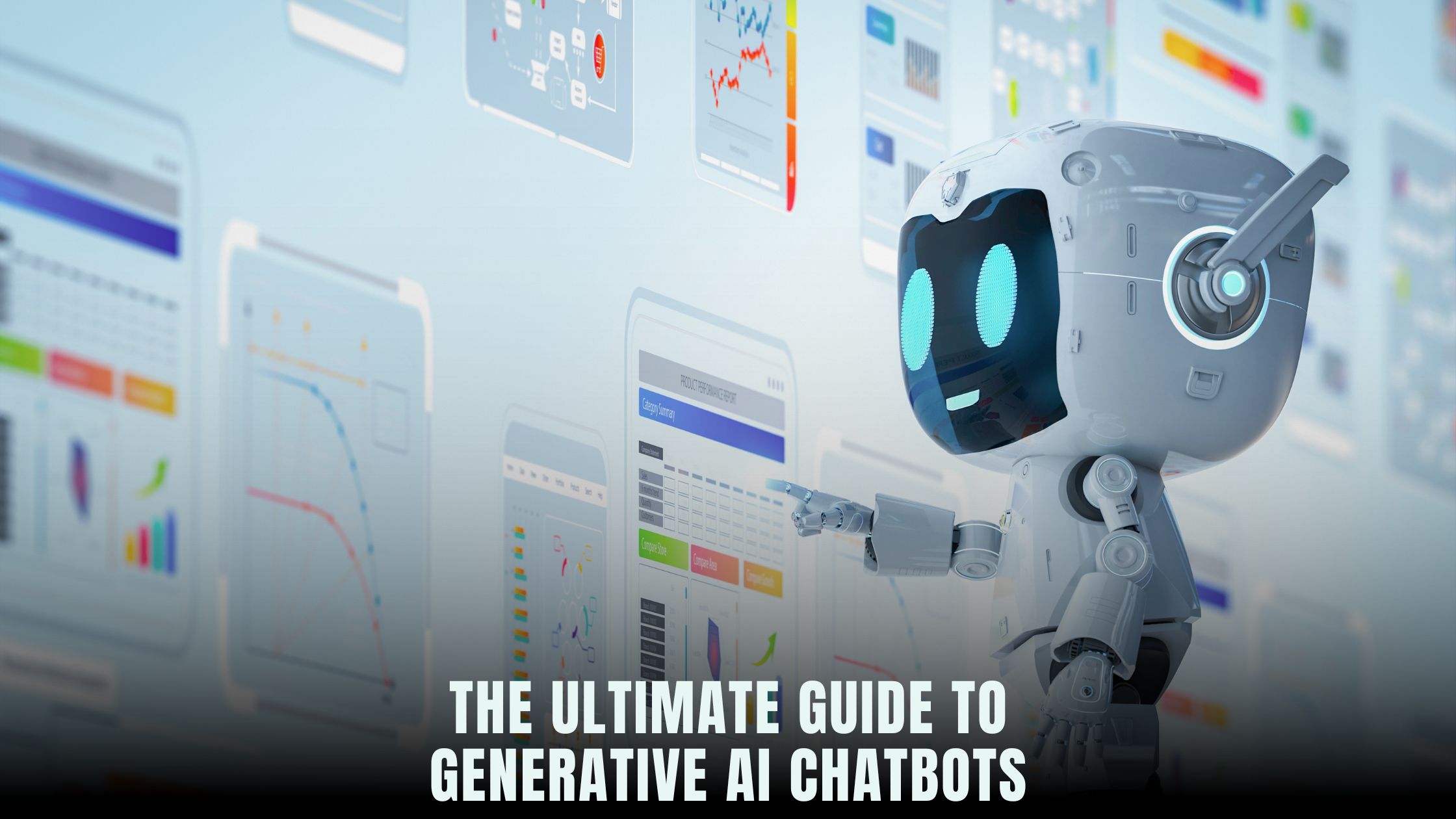The Ultimate Guide to Generative AI Chatbots
- AI Image Generators Software AI Writing Assistant Popular Tools AI Tools


Generative AI chatbots have revolutionized the way businesses and individuals interact with technology. From customer service to content creation, these AI-powered tools are transforming industries with their ability to generate human-like text and engage in meaningful conversations. This guide will explore the best generative AI chatbots available today, their use cases, and how they can be leveraged to improve various aspects of business and personal productivity.
What is a Generative AI Chatbot?


(Source – https://verge-ai.com/wp-content/uploads/2023/10/2-1024×576.webp)
A generative AI chatbot is a sophisticated artificial intelligence application designed to produce text or speech responses based on user input. Unlike traditional rule-based chatbots that rely on predefined scripts and limited responses, generative AI chatbots leverage advanced machine learning models, particularly those based on deep learning and natural language processing (NLP). These models allow the chatbot to generate responses in real-time, enabling it to engage in more natural, fluid, and complex conversations.
The key advantage of generative AI chatbots is their ability to understand and adapt to a wide range of contexts and user needs. They don’t just respond to specific keywords or phrases; instead, they analyze the entire conversation, taking into account the nuances of language, user intent, and even the emotional tone. This makes them capable of handling more sophisticated tasks, such as providing personalized recommendations, engaging in open-ended dialogues, or assisting with complex problem-solving.
Generative AI chatbots are increasingly used across various industries, from customer service and e-commerce to healthcare and education. They offer significant benefits, such as improving user engagement, providing 24/7 support, and reducing the need for human intervention in routine interactions. As AI technology continues to evolve, generative AI chatbots are expected to become even more advanced, further enhancing their ability to mimic human-like conversation and offer more value to users and businesses alike.
What is the Difference Between Generative AI and ChatGPT?


The difference between Generative AI and ChatGPT lies in their scope and application. Generative AI is a broad category of artificial intelligence designed to create new content, encompassing a wide range of outputs such as text, images, music, videos, and even code. This technology uses complex algorithms and deep learning models to generate original content that mimics human creativity. Generative AI can be applied across various domains, from creating artwork to writing articles, composing music, and beyond.
ChatGPT, on the other hand, is a specific application of generative AI developed by OpenAI. It focuses exclusively on generating human-like text in a conversational format. ChatGPT is designed to engage in dialogue with users, responding to prompts in a way that feels natural and contextually relevant. While it represents a powerful instance of generative AI, ChatGPT is primarily used for tasks like answering questions, providing information, and assisting with text-based communication.
In essence, generative AI is the overarching technology capable of creating a wide array of content types, while ChatGPT is a specialized implementation of this technology, tailored specifically for conversational text generation. ChatGPT is one of the most well-known generative AI models, but it is just one example of how generative AI can be applied. Other examples include AI models that generate artwork, compose music, or create realistic images, each leveraging the underlying principles of generative AI in different ways.
Examples of Generative AI Chatbots
Here are some of the top generative AI chatbots available in 2024:
- ChatGPT: The original and most popular generative AI chatbot, known for its versatility and wide range of applications.
- Claude: Developed by Anthropic, Claude focuses on creating interfaces with artifacts, offering a unique user experience.
- Meta AI: An open-license chatbot developed by Meta, known for its adaptability and integration capabilities.
- Google Gemini: A chatbot with the largest conversational memory, making it ideal for long and complex interactions.
- Microsoft Copilot: Combines online search, text generation, and image creation, making it a comprehensive tool for productivity.
- Zapier Central: Tailored for creating custom assistants, Zapier Central allows businesses to build AI tools that fit their specific needs.
- Poe: Offers multiple AI models in one platform, giving users the flexibility to choose the best model for their needs.
- Perplexity: Known for its deep internet search capabilities, Perplexity is ideal for research and information retrieval.
- le Chat: An open-source chatbot that offers customizable features for developers and businesses.
- Jasper Chat: Focused on content creation, Jasper Chat is a go-to tool for marketers and writers.
AI Chatbot Use Cases
Generative AI chatbots are used across various industries for different purposes:
- Customer Service: AI chatbots like Zendesk’s generative AI bot provide personalized support, reducing response times and improving customer satisfaction.
- Content Creation: Tools like Jasper Chat assist writers and marketers in generating content, from blog posts to social media updates.
- Sales and Marketing: Chatbots like ChatSpot are designed to help sales teams automate outreach and follow-ups, increasing efficiency.
- Learning and Education: Khan Academy’s Khanmigo offers personalized tutoring, helping students learn at their own pace.
- Productivity: Personal productivity tools like Merlin and ZenoChat help users manage their tasks and schedules more effectively.
How to Choose the Right AI Chatbot


(Source – https://encrypted-tbn0.gstatic.com/images?q=tbn:ANd9GcRfkMVIyQ_ASFb89DdS8JJEbZukRV7dOpmNnQ&s)
Choosing the right AI chatbot depends on your specific needs and goals. Here are some factors to consider:
- Purpose: Determine the primary function of the chatbot. Are you looking for customer support, content creation, or personal productivity?
- Integration: Ensure the chatbot can integrate with your existing tools and platforms.
- Customization: Look for chatbots that offer customization options to tailor the experience to your needs.
- Ease of Use: Choose a chatbot with an intuitive interface that is easy to set up and use.
- Cost: Consider your budget and evaluate the cost of the chatbot, including any subscription fees or additional charges for premium features.
AI Chatbot Best Practices
To get the most out of your AI chatbot, follow these best practices:
- Define Clear Objectives: Before implementing a chatbot, outline your goals and how the chatbot will help achieve them.
- Train the Chatbot: Provide the chatbot with relevant data and train it regularly to improve its accuracy and performance.
- Monitor Performance: Use analytics to track the chatbot’s performance and make necessary adjustments to improve user satisfaction.
- Ensure Security: Protect user data by implementing strong security measures and following privacy regulations.
- Regular Updates: Keep the chatbot updated with the latest features and improvements to maintain its effectiveness.
The Future of AI Chatbots
The future of AI chatbots is full of potential, with rapid advancements in machine learning and natural language processing (NLP) paving the way for significant innovations. As generative AI models continue to evolve, chatbots are expected to become increasingly capable, handling more complex and diverse tasks with greater efficiency.
One of the most exciting prospects is the ability of future AI chatbots to provide highly personalized experiences. By leveraging vast amounts of data and more advanced algorithms, these chatbots will be able to understand users on a deeper level, offering tailored responses, recommendations, and solutions that cater to individual preferences and needs. This level of personalization could revolutionize customer service, e-commerce, healthcare, education, and many other sectors, making interactions with AI more intuitive and satisfying.
Moreover, as generative AI models become more sophisticated, chatbots will likely move beyond simple text-based interactions. We can anticipate the integration of multimodal capabilities, where chatbots can understand and generate not just text, but also images, videos, and even audio. This would enable more dynamic and engaging conversations, allowing chatbots to assist with a broader range of tasks, from visual problem-solving to creative collaboration.
In addition to these advancements, the increasing integration of AI chatbots into everyday applications and services suggests that they will become indispensable tools across various industries. Businesses may rely on AI chatbots for automating routine tasks, enhancing customer engagement, and providing around-the-clock support. In healthcare, chatbots could assist with patient monitoring and personalized care plans, while in education, they might serve as interactive tutors, adapting to each student’s learning style.
As these technologies mature, ethical considerations will also play a crucial role in shaping the future of AI chatbots. Ensuring that these systems are transparent, fair, and respectful of user privacy will be essential to building trust and maximizing the benefits they offer.
Overall, the future of AI chatbots promises to be transformative, with the potential to significantly enhance how we interact with technology and each other.
Conclusion
Generative AI chatbots are powerful tools that offer numerous benefits, from enhancing customer service to improving productivity. By understanding the different types of AI chatbots and their use cases, you can choose the right tool for your needs and leverage the power of AI to achieve your goals. As technology evolves, staying informed about the latest developments will ensure you remain at the forefront of this exciting field.
This guide has provided a comprehensive overview of generative AI chatbots, answering common questions and offering insights into the best tools available. Whether you want to implement a chatbot for your business or simply want to explore the possibilities, this guide is your ultimate resource.
List of Generative AI Chatbots to Checkout
- Meta AI: https://ai.facebook.com/meta-ai/
- Google Gemini: https://gemini.google.com/ (See Gemini’s Product Overview)
- Microsoft Copilot: https://www.microsoft.com/en-us/microsoft-365/copilot
- Zapier Central: https://zapier.com/ (See Zapier’s Product Overview)
- Poe: https://poe.com/ (See Poe’s Product Overview)
- Perplexity: https://www.perplexity.ai/ (See Perplexity’s Product Overview)
- le Chat: https://mistral.ai/ (See Mistral’s Product Overview)
- HuggingChat: https://huggingface.co/chat/
- Pi: https://heypi.com/
- You.com: https://you.com/
- Jasper Chat: https://www.jasper.ai/chat (See Jasper’s Product Overview)
- Chat by Copy.ai: https://www.copy.ai/
- ChatSpot: https://chatspot.ai/ (See Hubspot’s Product Overview)
- Salesforce Einstein Copilot: https://www.salesforce.com/products/einstein/ (See Salesforce’s Product Overview)
- Intercom Fin: https://www.intercom.com/fin (See Intercom’s Product Overview)
- Ada: https://www.ada.cx/
- Botsonic: https://www.botsonic.io/
- Sendbird AI Chabot: https://sendbird.com/ (See Sendbird’s Product Overview)
- Personal AI: https://www.personal.ai/
- Character.AI: https://beta.character.ai/
- Snapchat My AI: https://www.snapchat.com/ (See Perplexity’s Product Overview)
- Khan Academy: https://www.khanacademy.org/
- GitHub Copilot: https://github.com/features/copilot (See Github’s Product Overview)
- Amazon Developer: https://aws.amazon.com/q/developer/ (See Amazon Web Services (AWS) Product Overview)
- Tabnine: https://www.tabnine.com/
- Codeium: https://www.codeium.com/
- List of more chatbots – here & here
Additional reading
- Wikipedia’s Moment of Truth -Can the online encyclopedia help teach A.I. chatbots to get their facts right — without destroying itself in the process?
- Wikipedia – ChatGPT
- Wikipedia – Gemini (chatbot)
- ChatGPT and generative AI chatbots: challenges and opportunities for science, medicine and medical leaders
- What ChatGPT and generative AI mean for science
- Artificial muses: Generative artificial intelligence chatbots have risen to human-level creativity
- Chatbots and mental health: Insights into the safety of generative AI
- Developing generative AI chatbots conceptual framework for higher education
- Enhancing customer chatbot experiences through AI
- AI Chatbot Customer Service: Enhancing Customer Support with Artificial Intelligence
- Future of Customer Service: Importance and Trends in Chatbot Technology
- Boost Customer Engagement with Accordian: The Credible AI Chatbot for Your Business Website
- Advantages of AI-Powered Chatbot: Benefits of Artificial Intelligence in Customer Interaction
Additional Videos
- Ultimate Guide to Generative AI for Businesses
- Ultimate Guide to Building Chatbots to Chat with Your Data | AI Chatbot Tutorial
- AI Chatbots: Your Ultimate Guide for 2023
Your Complete Guide to Generative AI





